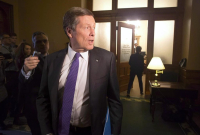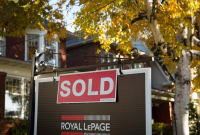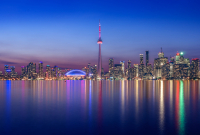It's easy to make mistakes when you’re building North America's fourth-largest city.
Toronto's population has grown by almost 350,000 since 2011, and has reached almost six million people. Housing prices have soared, climbing a third since last year alone. Toronto's chief planner Jennifer Keesmaat is at the centre of the struggle to manage that growth. At the same time, she's in charge of undoing many of the decisions from the past that often prioritized cars and concrete instead of people and nature.
As the city’s top planner since 2012, she’s pushed for ‘complete communities.’ This would mean creating spaces where people can choose to live and work without a painfully long commute by car in bumper-to-bumper traffic. She’s an outspoken advocate for dismantling the dominance of the car, and has supported policies to expand and improve Toronto’s transit system and make the city friendlier to pedestrians and cyclists.
Keesmaat hasn’t shied from taking on the city’s government when politics and her planning priorities have diverged. Case in point: her high-profile scrap with Toronto Mayor John Tory after she publicly supported the removal of part of the Gardiner Expressway, a concrete hulk that stands between Toronto's centre and waterfront.
Her support for cycling and transit was a politically-charged position when she was hired midway through Rob Ford's tenure. The former mayor compared bike lanes to “swimming with the sharks,” and said of cyclists killed by drivers that “it’s their own fault at the end of the day.”
Now, dozens of big projects are underway to re-design the fabric of the city as Toronto grows. Among them: bike lanes on Bloor St., a redesign of King St. to favour pedestrians and public transit on the street (Toronto’s busiest route for bus and streetcar transit), as well as plans for a 21-acre downtown park over a railway line to bring more green space into the city’s condo-heavy south end.
These, and less splashy work like rezoning the city’s avenues to encourage mid-rise growth, are part of what Keesmaat calls “urban repair.” That means creating multi-use communities in a city that, in many parts, was built with the exact opposite in mind.
“There was a generation of thinking that was all about separating uses: you work in one place and you live in another place," Keesmaat told National Observer. "It was based on the assumption that everybody would drive, full stop.”
National Observer spoke with Keesmaat recently about the myth of the short commute and the challenge of balancing growth, affordability and character in one of Canada’s fastest-growing cities, bringing nature back into the city and more. Here’s a transcript of that conversation, edited for clarity and brevity:
Toronto has hit growth targets much earlier than expected. What can the city do to integrate more people, without building a condo on every corner?
"One of the challenges that we have is that we are experiencing something of a vortex sucking all kinds of growth right into the heart of the city. One of the really important roles for municipal government to play is to ensure that we have clarity as to where growth will go, as well as where growth won’t go.
Seventeen per cent of our city is ravines; we’ve just brought forward additional environmentally-sensitive areas. We don’t want growth in those areas. There are also some areas that have heritage designations, and we want to be very careful in terms of how we manage growth in those areas.
We also recognize that there are areas that can benefit in a really significant way from growth. Our downtown, of course, 40 years ago – there were a ton of surface parking lots. Today, we in fact are in-filling the downtown, turning it into a truly walkable place.
We also see that opportunity on many of our avenues, because many of our avenues have great transit, two-storey (zoning), they’re adjacent to neighbourhoods that have great parks and schools. We can accommodate density on those avenues in a relatively gentle way: mid-rise, between six to eight storeys. Those are the places where we can accommodate this growth, while enhancing the walkability of the city, enhancing the transit-oriented nature of the city.
That’s our goal. As we grow, we want to become more and more sustainable over time."
You’ve talked about creating ‘complete neighbourhoods’ that people can live in and work in. Not necessarily in the suburbs, but further out of the city, on the end of Dufferin St. or Yonge St., for example. What would that look like and what can the city do to stimulate that kind of development?
"A really big part of what we’re engaged in in a lot of our suburban communities is a form of urban repair. There was a generation of thinking that was all about separating uses: you work in one place and you live in another place.
It was based on the assumption that everybody would drive, full stop. Everybody is going to have a car. Well, we know that cars are costly, and we know that creates incredible traffic congestion in the city.
So the urban repair that we’re engaged in right now is really about looking at those areas of the city that are missing some uses – might be employment, might be community facilities – that need to be added into the urban fabric of the city in order to create a complete community, so that there’s the option of doing more things within walking distance of home, or a short transit ride or cycle."
It seems like a logical idea at this point that you don’t really want to do that hour-and-a-half commute. I can’t imagine a time when that would have been a desirable idea.
"It’s really interesting, because I don’t think there was any intention, ever in the history of planning, to say ‘Let’s create a long commute.’ That was an unintended outcome.
There were a variety of decisions that were made, and they were actually based on a very different vision. The vision in the 50s and 60s was you would work in the downtown, you would get in your car onto a superhighway, music blaring, a nice quick ride – it would only be 10 or 15 kilometres – to then get to your suburban neighbourhood where you could have a big lawn and a big house, far away from the constraints of the inner city.
Of course, that dream never actually held. The minute that we started designing communities and separating out the uses and connecting them by highways, assuming people would drive everywhere, almost instantly, the urban fabric of the city was filled with congestion. There hasn’t been a time when there wasn’t traffic congestion.
Even in 1924, just when Ford really started pumping out the mass production of cars, within years the streets were gridlocked. It happened instantly. It’s a simple matter of physics: cars take up a lot of space, compared to how much space you just take in terms of your body.
If you want a dense environment where you can do a whole lot of things, there’s just not a lot of room to put all of those cars.
We’ve sort of accepted it, and I think we’re just at a moment in history where people are going ‘Hold on a minute.’ The long commute is actually a really crummy quality of life, and I would rather live in a smaller footprint, having shared parks instead of my big grassy lawn, and instead get two hours back in my day because I don’t have to sit in a car, pay those car payments, pay for insurance, pay for gas.
I think part of what we’re seeing now is a recognition that there were all of these unintended outcomes as a result of separating out the land uses, and assuming that planning around and planning for the car was in the best interest of creating a really livable city. It just turned out that wasn’t true."
There a lot of pressures facing neighbourhoods in Toronto – Parkdale, Kensington or the Junction, for example. In terms of affordability, character of the neighbourhood and growth, how do we balance those?
"Affordability in a rapidly growing city that is highly desirable and is attracting people from literally all over the world, and capital from all over the world, really creates some serious challenges. New York has this problem; London has this problem; Paris has this problem. And unfortunately now Toronto has this problem as well.
It really speaks to the importance of strong public policy, to respond where the market cannot. There is always going to be a component of people who are left out of the market, and that’s where strong public policy comes into play.
If you look at Germany, every single development project in Germany is a third social housing, a third affordable housing, a third market housing. We, in fact, have had a primarily market-driven approach to housing, and as our cities become more and more attractive on a global stage, this is the moment in history to say we actually need more policy to ensure that everyone is included in our city – that no one is left out."
I do get the sense, though, that when you look at the south end of Toronto, for example, there is the appetite to build those kind of condos basically forever. How can you rein in the market without driving developers away? Is it just that Toronto is a desirable enough place to live that the market will respond, even with those restrictions in place?
"This is where public policy is often a delicate balance. One of the things that we’ve been pursuing, and have been working very closely with the province on, is inclusionary zoning. Inclusionary zoning exists in over 500 cities in the States – in New York, in Washington. Inclusionary zoning puts a requirement to build affordable housing as part of every market housing project. That’s a way of having a public policy that piggybacks off the market to ensure that the housing needs of everyone in the city are in fact going to be met.
That’s one example of a tool. Could it kill the market? Well, interest rates going up by two per cent could kill the market. There are a lot of variables when it comes to the housing market, which is why there’s no sweeping solution."
Is anyone in Canada doing that well?
"We’re actually doing this really well in certain spots in the city. Our West Don Lands is an area that was master planned. In that area, we have secured as part of the master agreement, 20 per cent affordable housing. There’s student housing, there’s social housing, there’s also rent-geared-to-income housing, that are all part of that new master-planned community.
So on our large sites, it’s actually something that we’ve done quite well. The spot where we haven’t done it quite well is on individual development parcels. That’s the area where inclusionary zoning could really fill in the policy gap that exists today."
On the smaller sites, are we talking about a city-wide policy or targeting individual sites?
"There are a lot of different ways that could be implemented, but the land economics of the city of Toronto are vastly different if you’re standing in downtown Toronto or you’re on the edge of Scarborough.
We currently have a pretty nuanced approach, and it’s nuanced because it recognizes that the land economics of a particular site are very different from the land economics are very different from a site five blocks away.
Having many areas of the city currently down-zoned allows us to be responsive. Other areas of the city, we have in fact up-zoned. For Eglinton Avenue, 26 per cent of the corridor, which is currently about two storeys, has been up-zoned to about eight storeys, and that is to facilitate bringing in that mid-rise form along our avenues."
You’ve talked about historical mistakes made in terms of how we deal with nature in the city – water, for example. What do you see coming in terms of re-integrating that, and what do we actually want?
"A generation ago, it was all about conquering nature and over-engineering the city. There are many places in the city where there were streams and we essentially encased them in concrete and built on top of them and said, ‘Good thing we got that stream out of the way.’
As the water table has risen in the city, it has put pressure on the infrastructure, and also put pressure on other storm water systems. So the new model, which is very much a model that’s being advocated by the Dutch, is really about recognizing that water should come into the city, and it will come into the city.
We can plan for water levels to go up and for water levels to go down, but also for storm water management to be a visible part of the landscape of the city. We can actually have amenities centred around storm water features in the city, not unlike what we have in our ravine system.
The new model is really about saying let’s work with nature – let’s actually recognize that we want to bring nature into the city. We want wildlife in the city, we want trees in the city. This is a critical part of creating a livable urban environment, as opposed to the city noir, the concrete jungle. We’ve recognized that’s actually pretty hard on human health.
Features around storm water, for example – what would that look like?
"There’s a tremendous amount of work we’ve done around naturalizing the mouth of the Don River, which flows from the hinterland right into Lake Ontario. The mouth of the Don has been contaminated and polluted, and in many ways destroyed. Bringing back the shoreline, managing the water flow, getting the combined sewers out of the water – all of that is a critical part of beginning to see water as an important part of urban life."
You’re not a politician, but there are political implications to a lot of these decisions. If we look back at the recent history of Toronto, there was a resistance to things like bike lanes, for example. Within a fairly short period of time, you’ve done a lot of things like adding bike lanes on Bloor, trying to increase the pedestrian friendliness of the city – do you worry that there might be some pushback to that coming over the next couple of years, from doing too much too quickly?
"There are different schools of thought. One school of thought – which I would actually say has historically been the Toronto school of thought – is that you take a few steps forward, you pause, you evaluate, you collect lots of data, then you take a couple more steps forward. That’s a model that’s particularly risky if you’re very, very far behind, because it means you’ll never catch up – you’ll never get ahead.
We are growing so quickly that on the one hand, we’re transforming the city, and on the other hand there are these ways that we need to be changing the key infrastructure of the city, like the use of the ravines, like the use of our streets, making them more into people-places as opposed to car-places. The risk is that if you add lots of growth but you don’t actually catch up quickly, that you’re going to begin to destroy the quality of life in the city.
So I would say there’s not too many areas where we’re going too fast. I don’t think that’s our problem."






Comments
I once again object to this April 2017 story being featured as a "Top Story" on July 30, 2018. Sure, Keesmaat is in the news now because she decided to run for mayor of Toronto. That's worth a story, and this April 2017 piece can then be linked as a "related story." But no top billing, please! This is so misleading. You had me again.
I was inspired to read this article by a citizen and planner whose job it is to create plans. This is very different from the arguments that say the market is the only measure, where ideas are ridiculed and trashed. If our species is unable to appreciate problem solving because lobbies are so equipped with counter arguments, as if there is a fear of human activity that is not strictly driven by corporate economics, we lose our ability to talk and think about social improvement. Thank you for this article and for the calm voice of Jennifer Keesmart.